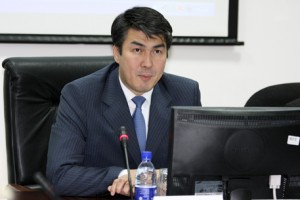 ASTANA, Nov. 4 – Innovation is happening in Kazakhstan and productivity in the country’s manufacturing sector has increased two times faster than in Russia’s and five times faster than in Ukraine’s, Deputy Prime Minister and Minister of Industry and New Technologies Asset Issekeshev wrote in a recently published report summing up the implementation of the first five-year section of the programme of the country’s industrial and innovative development.
ASTANA, Nov. 4 – Innovation is happening in Kazakhstan and productivity in the country’s manufacturing sector has increased two times faster than in Russia’s and five times faster than in Ukraine’s, Deputy Prime Minister and Minister of Industry and New Technologies Asset Issekeshev wrote in a recently published report summing up the implementation of the first five-year section of the programme of the country’s industrial and innovative development.
The minister noted that until 2010, Kazakhstan’s manufacturing industry was struggling, but state support has now fostered growth in the sector. “Over four years, labour productivity grew by 300 percent in the pharmaceutical sphere and 70 percent in metallurgy, due to the modernisation of large enterprises. Projects to support businesses were launched. We see issues that need to be solved, taking into account the experience of the first five-year plan.”
Several types of challenges are still to be addressed by state and national companies. Key challenges include low-quality projects coming from the regions, a shortage of human resources and difficulty in accessing financing and infrastructure.
“Integration into the Customs Union and the WTO [the World Trade Organisation] means Kazakhstan companies are facing no small pressure to increase competitiveness. This is a big challenge that will dominate the next 5-10 years. Another challenge is the ‘middle income trap,’ in which countries that have reached a certain level of income experience difficulties in reaching further qualitative growth,” Issekeshev said.
Employment is also an ongoing concern. “We see that the new technologies and trade, in particular in electronics, are making the U.S. lose 100,000 jobs every year, and this process will continue to grow. Labour productivity in the oil and metallurgical sectors will continue to drain jobs elsewhere. Employment is a very serious global issue,” Issekeshev said. The creation of two million quality jobs in Kazakhstan by 2030, he said, is quite a significant issue. The next challenge is the constant evolution of technology, a serious challenge for business, according to Issekeshev.
From 2010-2014, Kazakhstan’s State Programme of Accelerated Innovative and Industrial Development (PAIID) helped create 872 new projects in the country, saw investments of $71.3 billion and created 421,000 jobs.
The task of the second five-year period under the programme is to raise Kazakhstan’s export output. “Kazakhstan will need to remove all export barriers. To do this, utmost support for Kazakhstan’s businesses is needed. It is also impossible to solve this problem without export financing,” Issekeshev said.
Development of the second five-year development programme began one and a half years before the end of the first one. In May, the Ministry of Industry and New Technologies will submit its next plan for the president’s signature.
Alexey Prazdnichnykh, a member of the expert group assessing the programme, noted that the performance of the manufacturing sector is expected to grow in the next five years by more than 90 percent and that exports should double. He noted that Kazakhstan had company in pursuing its industrial development programme and that similar plans had been launched in the U.S. and the EU.
According to Prazdnichnykh, the programme provides a balanced approach that supports not only the current economic mainstays of oil, gas and natural resources, but also helps smaller sectors like engineering and agriculture and innovative sectors that will be the economy of the future.
“In our view, it is dangerous to rush to extremes in supporting only one sector. The key goal is the balanced development of all three groups of sectors,” Prazdnichnykh said.
Kazakh producers may be interested in other markets to deliver their products. Most sales go to the border regions of Russia, followed by the overall market in Russia, Ukraine and Belarus. The third largest group includes the western regions of China; the fourth area includes the rest of China, Uzbekistan, Tajikistan, Turkmenistan and Kyrgyzstan, while the fifth group includes Turkey, Iran, Iraq and Azerbaijan.
“The main thing for us is helping regional clusters, where initiatives for developing industries at the regional level will be supported. It is proposed to allocate several clusters: national, regional and innovative,” he said.

